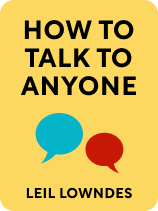

This article is an excerpt from the Shortform book guide to "How to Talk to Anyone" by Leil Lowndes. Shortform has the world's best summaries and analyses of books you should be reading.
Like this article? Sign up for a free trial here .
Do you find it easy to strike up a conversation with a new person? What is the key to getting people to talk to you?
According to Leil Lowndes, the author of How to Talk to Anyone, people need to know you like them to want to talk to you. However, many people struggle to show others they like them because they focus on making others like them. The solution is simple—stop trying so hard to get liked, and instead, show others how much you like them.
Here’s how to get people to talk to you, according to communications expert Leil Lowndes.
People Need to Know You Like Them
In her book How to Talk to Anyone, Leil Lowndes explains how to get people to talk to you. The key, she says, is to show people you like them. People will only want to talk to you if they know you like them. This is because, no matter the context—social or professional—everyone wants to feel adored, appreciated, and good about themselves.
Lowndes argues that the need to be liked governs all social interactions. When people are unsure about whether or not you like them, they feel self-conscious. This makes them feel uncomfortable and they struggle to engage with you. On the other hand, when they’re sure that you like them, they feel at ease around you and enjoy your company—they like you because you make it easy for them to feel good about themselves.
(Shortform note: Behavioral analysts add further insights into why being liked is so important to us, and how liking others encourages them to like you. First, the need to be liked evolves from the need for cooperation to survive: The more likable you are, the more willing people are to provide for your emotional and physical needs. This desire to have your needs met leads you to gravitate towards the people who like you. Second, like Lowndes says, when someone knows you like them, they subconsciously feel happy—over time, they’ll automatically associate your presence with feeling happy. This encourages them to seek you out so that they can experience more positive and uplifting emotions.)
While showing people you like them sounds quite simple, many people find it difficult to put into practice because they let discomfort get in their way. When you meet someone, you also want them to like you. This can create discomfort and a fear of rejection, which, according to Lowndes, has a self-fulfilling effect: The more uncomfortable you feel, the more likely you are to unconsciously emit nonverbal and verbal “I don’t like you” signals—thus repelling the very people you wish to engage with.
(Shortform note: Psychologists clarify how fear of rejection impels you to behave in ways that repel others. The more sensitive you are to rejection, the more likely you are to expect rejection, actively look for proof that others don’t like you, and ignore proof that they do like you. This misperception of how others feel about you leads you to behave in maladaptive ways that make others feel uncomfortable, such as becoming overly ingratiating, withdrawing emotionally, or acting defensive or hostile.)
Lowndes suggests a simple solution to overcome your discomfort and send welcoming signals to the people that you want to talk to: Switch your focus from how you want to feel to how you want to make them feel.

———End of Preview———
Like what you just read? Read the rest of the world's best book summary and analysis of Leil Lowndes's "How to Talk to Anyone" at Shortform .
Here's what you'll find in our full How to Talk to Anyone summary :
- Practical techniques to help you overcome social discomfort
- How to confidently develop new connections
- How to appear more likable without saying a word






